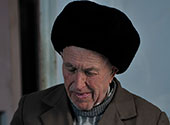
Semyon Skliarskii was born in Lypovets in 1926. His father was a furniture maker. His mother died when he was three years old and his father passed away four years later. He was brought up by his mother’s sister. He began his schooling in a Yiddish school, and completed his education in a Ukrainian language school. He survived most of the war in hiding in the Reichskommissariat Ukraine. Toward the end of the war, he joined a group of partisans. After the war he worked as an accountant. He married a woman from Bershad in 1951 and moved to Bershad in 1969.
Other Interviews:
"don't run into the forest"May 27, 1942: Zhornyshche
Bershad, Ukraine
The war began in the village of Zhornyshche on July 16, 1941, when the German Sixth Army occupied the village on its way from Vinnytsya to Uman. The Germans quickly turned the administration of the village over to a headman, a chairman of the village council, and two Ukrainian policemen. A few weeks later, the local Ukrainian police led a group of about a dozen Jewish men, including one thirteen-year-old boy, to a clubhouse, and shot them.
Soon thereafter all the Jews of Zhornyshche were required to wear a Jewish star on their arm and back, and were put to work, carrying stones for the construction of roads. Just as in every other town in the region, a small ghetto was established. Word reached Zhornyshche the night of May 26, 1942 that pits had been dug in the nearby town of Ilnytsya. That night, the village elder’s son, who had seen the pits and understood their purpose, ran the 8 kilometers from Ilnytsya to Zhornyshche to warn the Jews of what was to come. He had many friends among the Jewish children of Zhornyshche and hoped to save them. He ran in circles around the village warning anyone he could find, but Ukrainian police had already surrounded the village. Shloyme Skliarskii’s three aunts together with their children managed to hide, but Skliarskii was left outside. Even his half-brother, Yasha, who was a mere three months younger than Skliarskii managed to hide in the attic with the rest of the family.
The next morning, all the Jews of Zhornyshche, with the exception of a few who had specialized skills, were ordered to march together under guard to Ilnytsya. “Two tailors, two cobblers, and two glaziers were left behind,” Skliarskii explained. “I mean the tailor and his wife—each one and his wife were left so that the non-Jews could learn how to work. So these ones weren’t taken, at least not immediately.” A Noah’s Ark of survivors was to remain, not to repopulate the village, but only to train replacements among Christian apprentices after which they too would be eliminated. The massacre, Skliarskii recalled, was led by Police Captain Zavalinsky, a local Ukrainian who had been a stable boy before the war; since he had ethnic German roots, the new authorities had promoted him to police captain soon after the town’s occupation. It was Zavalinsky, Skliarskii told us, who pulled the trigger, sending a bullet into Skliarskii’s upper left arm as he fled the column marching down the road.
According to testimony taken by a Soviet Extraordinary Commission in Ilnytsya immediately after the war,
The Germans arrested more than 800 civilians, put them in a building that had been a Jewish school, where the arrested were subjected to inhuman suffering and tortures; they were all taken to the field and shot.
According to another witness, Shloyme Yablonsky, who testified before the Extraordinary Commission in April 1945:
On April 24, 1942, while it was still morning in the village of Ilnytsya, regulars from the German army, along with police, conducted a round- up and caught nearly a thousand civilians, mostly Jews. They were taken under guarded convoy near the forest about 2 kilometers from Ilnytsya to a previously prepared grave. Before execution they were terribly humiliated and forced to undress. Then they were all executed; among them were many women and small children. The Germans did not shoot the children but threw them into the pits alive. On May 27, 1942 more than 800 civilians were also arrested and taken to the premises of a Jewish school. They were held there for one day and were not given food or water. After this, they were executed in the same manner as those who had been executed before and in the same place.
Liudmila Koroteska also testified to the Extraordinary Commission about both the April and May incidents and added the gruesome detail that after the massacre “the clothes they [the victims] were wearing were brought back to Ilnytsya and sold here.”
Source: Jeffrey Veidlinger, In the Shadow of the Shtetl: Small-Town Jewish Life in Soviet Ukraine (Indiana University Press, 2013)
